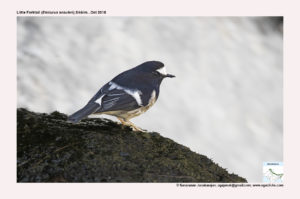Little Forktail

Little Forktail
Etymology:
- Enicurus : Greek word henikos – singular; ouros -tailed
- Scouleri : Named after Scottish naturalist John Scouler (1804–1871)
Vernacular Names: Lepcha: Ooong-sumbrek-pho
Distribution in India: Resident of Himalayas and hills of North East India.
Description: Size of 12–14 cm; Wt. of 11–19 g. It is the smallest Forktail, with notched, relatively short tail. It has a black head to upper breast, back, wings and central tail, with white rounded forehead. It has a white wing patch; area from lower back to rump is white with dark grey bar. The outer tail and lower breast to undertail-coverts are white with grey-dappled flanks. It has a black bill and pink legs. Both the sexes are similar. The juvenile is as adult, but with dark forehead, underparts are white with dark scaling.
Habitat:It is found in margins of montane watercourses, from small rocky streams. It prefers small to medium-sized streams, canyons, damp fern-clad gorges and associated dashing waterfalls. It breeds at 1800–3300m and winters at 1000–2000m.
Food habits: It eats aquatic insects and crustacean; like tipulids, beetles, ants, flies and some plant matter. The insects are taken to nestlings also. It forages by picking prey, dead and alive, off wet rocks, sometimes by standing in shallow rapids and picking out passing morsels, sometimes ascending water-washed rocks against current, sometimes body almost submerged, and sometimes submerging head entirely to take prey. It also forages gleaning from water and rock surface, also from adjacent leaves and grass; occasionally makes short flycatching sallies or hover-picks floating item from surface
Breeding habits: They breed in Apr in Afghanistan and Apr–Jul in Pakistan and India; from Mar for several months in South China. They have a territory of 200–500 m of stream. The nest is a compact cup made of living moss and moss roots, leaf fibre, leaves and grass, lined with leaf skeletons, rootlets and leaf parts, placed in hole in fern-clad rock or mossy bank or on tiny high ledge, often behind waterfall. They lay a clutch of 2–4 eggs.